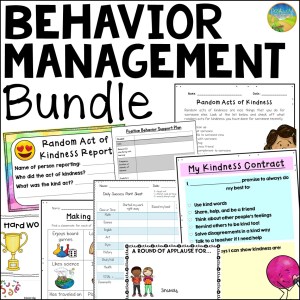
Not long after the “back to school” craze, students who struggle start to show their challenging behaviors. Behaviors such as being out of their seat, calling out, refusal to work, or arguing can really impact the flow and progress of the classroom. Other more serious behaviors, such as fighting, hitting others, biting, and running will also be significantly detrimental. As teachers, we have a LOT on our plates and can’t do everything all at once. These kids, though, are often calling for help in their own way. We owe it to them to work through the challenges, not only to improve our own classrooms but to help that student improve overall, too.
Here are some steps you can consider to support kids with challenging behaviors in the classroom:
1. Read the child’s file. This might seem obvious but sometimes it is a forgotten first step! This is a great way for teachers to do some initial research on a child, helping you to know what questions to ask the child and the family. Some things to look for within the file include: who the child lives with, if/how often the child has moved or changed schools, what types of behavioral challenges has the child had in the past, and what types of support services the child had in the past. Support services might include intervention supports, special education, or even just testing for special education.
2. Build your relationship. A strong relationship is the #1 intervention and support to help kids with challenging behaviors. Building a relationship takes time. Use these 10 techniques to work on building a positive rapport with your learners.

3. Talk to the child. Your approach for this will definitely vary depending on the student’s age. However, at any level, you will need to find time to meet with the student in a 1:1 setting and just talk. This should not be a punitive discussion, so I wouldn’t encourage doing this during a consequence or right when the student is caught doing something that would cause him/her to get in trouble. It’s best done in a supportive way. You can ask the child to have lunch with you, have the student stay after for extra help, or find time to meet with him/her during the day in another way. It’s important that the discussion time is one-on-one because many kids don’t open up about their challenges with peers or in bigger groups. This is probably especially true with middle and high school kids, but also for younger kids, too. During this meeting/discussion time, just ask questions to see what is going on with the child. You can start with, “I noticed that you’re having trouble with _____. What do you think is going on with that?” At first, kids will often say they don’t know. You have to keep talking and asking questions in a supportive way. If your student struggles with sitting still or focusing, another strategy is to do the discussion while doing something hands on such as drawing or playing with clay.
4. Talk to the child’s parents/guardians. When you initiate conversation with the child’s parents, it’s best to do it in a supportive way that invites collaboration and communication. The best way to do this is often the “sandwich” approach – something I LIVE by with all of my students! Before mentioning any concerns, mention something positive about the child to the parents. It could be that he/she worked really hard on a test, shared with peers, was a good friend to someone else, or anything at all positive. It just sets the tone for a positive conversation. What you don’t want is to offend or confront the parent and send them into attack mode. Once you mention a positive and start the conversation out right, then you can mention what the child has been struggling with. Pick one major thing to discuss, though, so that you do not overwhelm the parent. You can say something like, “I noticed that ____ is having trouble working with groups or partners. Have you been seeing anything like that at home with ____’s siblings?” Let it pave way for more discussion in a supportive way.

5. Problem-solve WITH the child. After getting feedback from the file, child, and parents, it’s time to make a plan. Meet with the child again and find out what strategies might help him or her. Again, the student might not know (or not know right away), but with further discussion and questioning, together you can come up with a plan. Offer ideas for accommodations on work if that is the problem. For example, if the child is not completing the math homework, would using a calculator make a difference? If the child struggles with group and partner work, would he or she prefer to choose a partner or maybe even work alone? Troubleshooting WITH the child is going to go a long way and make a difference.
6. Offer incentives. Some kids need to see light at the end of the tunnel and an incentive or reward is just that. Consider whether the child needs a daily reward or if he or she can wait for an end of the week reward. This will depend on the individual student. Talk to the student about what he or she would want to work for. Have a reward inventory, or list of possible rewards, written out for the child to choose from. Rather than only considering tangible “prize box” rewards, also offer activities: lunch with the teacher, helping in the office, telling the class a joke or story, extra gym time, and drawing/art time. Not only are these activities often big incentives, but they are a positive way to teach kids to spend their free time, too.
7. Make a contract. Whatever plan you come up with together, put the plan in writing. Write it with the student present and include ideas directly from him or her. That will allow the child to feel invested in the contract/plan, since they are an essential component. List out what goals the child is working on for appropriate behavior, what accommodations the teacher will provide to help, and exactly how the child can earn his/her incentive. Once the plan is set, have the student sign the plan and send a copy home to the parents, too.
8. Ask for support in your building. Go talk to the school social worker, guidance counselor, and/or school psychologist. Reach out to teachers who worked with the student in the past. Ask for what has worked in the past for the student, what hasn’t worked, and what ideas other educators have for you to try and implement. No single person has all the answers, which is why it’s important to reach out for support across your building. Even just asking a colleague to come into your room and observe might be a helpful strategy that will give you insight into what is really going on.
9. Revisit the plan often. A plan for supporting kids with challenging behaviors shouldn’t be set in stone. It will most likely have to change pretty frequently, both to change rewards/incentives and encourage new positive behaviors along the way. Have weekly or bi-weekly meetings with the student to discuss his/her progress and how the plan might need to change for the future.
10. Use de-escalation strategies. De-escalation strategies are the skills we as adults can use to defuse challenging situations. Read more about over 50 de-escalation techniques you can try in your classroom.

11. Teach social skills. Kids want to do well. Many times, they don’t have the skills to get there. Stop and consider what social skills your student might be lacking. Then, make a plan to teach those skills directly. You can teach them in a small group to your student with peer role models, but you can also always teach them to the entire class.
12. Give choice. Kids and teens who act out in challenging ways often feel like they have no control. Give them a piece of that control by allowing choice when you can. Let them choose which book to read. Allow them to pick which table they work at. You can even let them choose between which assignment to start first.
13. Be consistent. Kids and teens learn best when all educators are following through with the same rules and expectations. Meet up with colleagues who share that same student to make sure you are using the same language, interventions, and supports when possible.

If you need additional support for behavior management and social skills within your classroom, consider checking out this Social Skills and Behavior Management Mega Bundle. It’s a huge bundle that includes 12 products that help to increase positive behaviors while reducing challenging ones in the classroom. Materials contain social skills lessons, social skill task cards, social scripts and narratives, behavior intervention plans, classroom reward coupons, lessons teaching kindness, and much more.







Leave a Reply